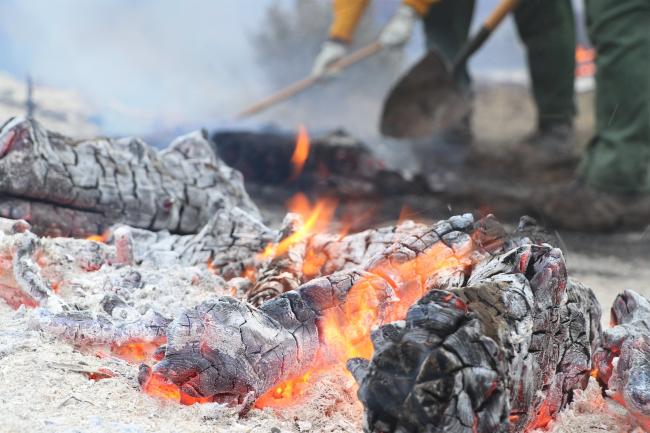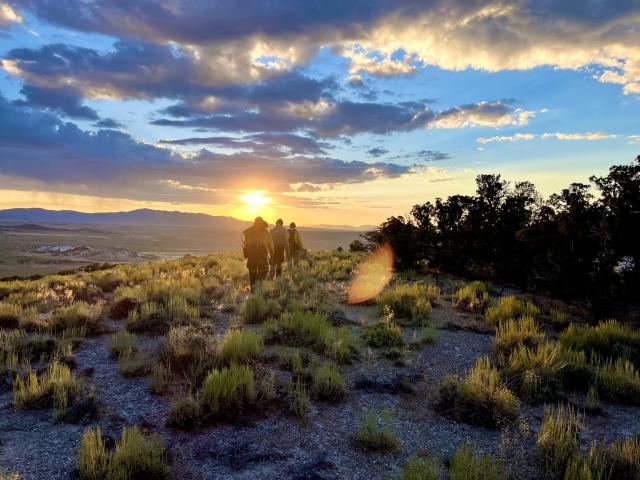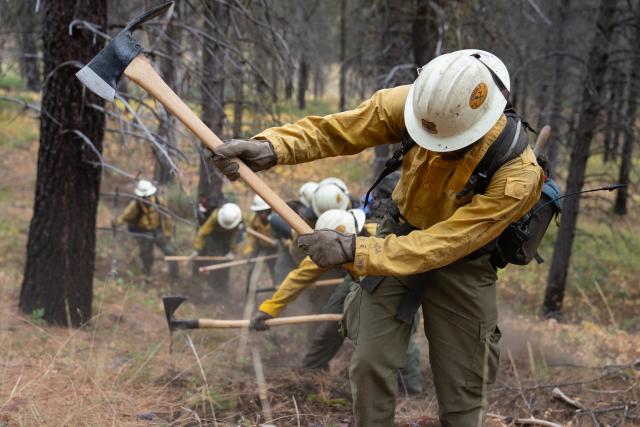BLM recognizes National Wildfire Awareness Month
Listen
Subscribe
Related Content
In recognition of Wildfire Awareness Month, On the Ground is kicking off a three-episode podcast series highlighting all things wildfires. The series dives into the critical roles, challenges, and innovations shaping how BLM Fire prevents and responds to wildfires today. You’ll hear seasoned wildland firefighters discuss behind-the-scenes management strategies, and learn about the National Interagency Fire Center’s safety tips for the everyday public lands user.
Transcript
NARRATOR [Mitchell C. Leverette, Public Affairs Specialist]: In 2024, there were approximately 84,897 wildfires reported nationally. These reported wildfires consume roughly 8.9 million acres of land, compared to only 2.7 million acres in 2023. As wildfires continue to remain one of nature 's most unpredictable and destructive threats to our infrastructure, environment and communities, awareness of fire risks, along with the general knowledge of how these blazes are professionally handled, can help communities reduce the likelihood of future fires starting in the first place.
My name is Mitchell Leverette, and you're listening to On the Ground, a Bureau of Land Management podcast. May 1st officially marked the start of National Wildfire Awareness Month, as around this time every year, the weather starts to warm up, and vegetation in various regions begin to dry out. All while more and more people begin to start heading outside to take advantage of the BLM 's beautiful public lands. I had the opportunity to speak with a small panel that offered various perspectives on wildfire management, and it was a true privilege to learn more about them, their strategies for the 2025 fire season, and how we can all be better prepared for wildfires. This conversation will be presented in three parts, so be sure to check back next week for part two.
LEVERETTE: So, looks like I'm here with Nick Howell, Eric Solomon, and Piper Brandt. You guys want to go ahead and state your district and job titles for the audience?
NICK HOWELL: Yeah, you bet. My name is Nick Howell, and I work in southwest Utah. I actually, live in Cedar City, Utah. But I worked for two districts, the Color Country and Paria districts, Paria River districts. Yeah, so I've been with the agency for about 25 years. I've worked a lot in operations. I currently work in investigations and fire prevention and education. So yeah, just kind of all over the place depends on the day.
LEVERETTE: Perfect, perfect. How about you, Eric?
ERIC SOLOMON: My name is Eric Solomon. I'm currently a fire prevention mitigation specialist. I work out of Apple Valley, California and I'm part of the California Desert District, which stretches from Mexico to Central California and Arizona, all the way to the ocean. So pretty much all of Southern California. I've been with the BLM for going on four years now and before that was eighteen years with the Forest Service and I've been in prevention since about 2008 and I'm one of the primary fire investigators here on the district.
LEVERETTE: Awesome. Thank you. Thank you. Let’s round it out with Piper.
PIPER BRANDT: Hey, my name is Piper Brandt. I'm a public affairs specialist with BLM Fire, and I work out of the National Interagency Fire Center in Boise, Idaho. I got started with the BLM as a seasonal park Ranger about a couple of years ago, and I spent a year with the BLM in Nevada. And then that led me to where I'm at now at NIFC and I've been here for about a year.
LEVERETTE: OK, great. Thank you guys for that. I'm just going to go ahead and get right into it by asking what is NIFC in relation to the BLM fire program?
BRANDT: Yeah. So, the National Interagency Fire Center, or NIFC, is a place, so it's not an organization or agency. It's a 55-acre campus that's owned by the BLM in Boise, Idaho. It's located right by the Boise Airport, you can. See it from the runway. There'll be a big, big flame painted on our smoke jumper tower that you can see from the airport when you fly in. So, many agencies work together, and if she and the goal is to make sure that fire personnel get the support and the information they need to do their jobs safely and effectively as possible. So, we've got about 650 year-round employees here and nine federal and state agencies that all work together at NIFC. Along with their directors or representatives for their respective fire programs.
LEVERETTE: What is the BLM fire program in charge of that really affects the public? What are they do that directly affects the, you know, the average everyday public lands user or recreator?
BRANDT: Yeah. So, BLM fire is responsible for fighting wildfires on, it's about 650 million acres of public lands. So, the places that the public likes to go, hike and camp and fish and any kind of recreation we're responsible for fighting fires on that land and also that means doing some preventative work called fuels management on that land. So those are projects that are aimed at reducing the likelihood of large destructive fires.
LEVERETTE: Awesome. Awesome. Has BLM fire been responsible for any sort of, you know, like content or tangible products creating the past regarding wildfire prevention or awareness since that's what this podcast is primarily about wildfire prevention and awareness?
BRANDT: Yes, we have a variety of different products that we've created. It's all for the public to access and learn what they can do to help prevent starting a wildfire on their public lands and around their communities. So the National Interagency Fire Center has a YouTube channel, and there are lots of videos about simple things you can do while on your outdoor adventures, like anything from safely target shooting to trailer safety, making sure your chains are wrapped up properly and not dragging on the ground which could spark and start a wildfire, um, and the big one is drowning your campfires before you leave them unattended. That's a big one. And we've also partnered with Recreate Responsibly to create a series of graphics with easy to remember tips while camping and hiking. We've even done a collaboration with Maverick First Adventure, so there's a series of spark safety, not wildfires, videos, and those have been played throughout gas stations in the West. Just with wildfire prevention tips. We have our own podcast called Wildfire Matters where we interview experts and have necessary information about every aspect of wildfire management. And that's just to name a few things.
LEVERETTE: That's cool. How were you guys able to get permissions from gas stations to get your videos played? That's kind of awesome.
BRANDT: Yeah, we have a contract with them and they were willing to collaborate with us. And so, they they've made their own videos and I think there's one video where they feature BLM Utah Fire crew in the video. So that's been a really cool, fun thing that we've gotten to.
LEVERETTE: Wow, that's cool. Maybe see Nick on a gas station TV one of these days. That’d be pretty awesome.
LEVERETTE: So, still talking about this planning process, say leading up to a campaign about, you know, spreading fire prevention awareness, how does BLM file usually approach their campaigns? Are there any key points or key strategies used in the process that you may feel are worth mentioning or with bringing up?
BRANDT: Yeah, we have a social media account, so we have an Instagram, a Facebook, and X (formerly Twitter) where we share prevention information regularly. And a big thing that we prepare for every year is Wildfire Awareness Month, which is coming up in May, where we share a lot of information on how to prevent wildfires and the importance of just being careful when you're out recreating about where you have your campfires, not leaving them unattended, making sure they're dead out before you leave. We also have the Nifc.gov website which has a ton of information including national fire news, preparedness levels, as well as a whole tab devoted to fire prevention where there's a lot of resources there as well. And then during active wildfires, we have teams of fire prevention folks that go out and talk to the public to help educate about fire restrictions and just spread more information about how to prevent fires.
LEVERETTE: OK. That's awesome. Yeah, that makes sense. Nick and Eric, do you guys have any experiences where you guys have had to go out into the field and - well, maybe not even necessarily in the field, but go out to public spaces and give oral presentations on fire awareness and prevention tips.
SOLOMON: So, for southern California, we're actually very lucky we have a lot of support for some of the larger events that we do here in Southern California. We do everything from the Temecula Valley balloon and Wine Festival to the LA County Fair to the Cal Expo State Fair in Sacramento. Some local community fairs, local larger county fairs. We do classroom presentations. We use Smokey Bear and children's education to raise awareness, and one of the biggest things that we do is we try to find some of the more populated, popular recreation spots and actually go out and patrol and speak with folks and say hi and introduce ourselves and make sure that folks that are camping and recreating are doing so safely. One of the big things that I've noticed as a prevention officer for so many years is most folks just don't know that some activities can cause fires. So. By taking a few moments to interact with those families and public land users and explaining to them that some of the things that they might be planning to do could potentially result in a damaging wildfire. It raises that awareness and it is just an opportunity for us to talk to folks and educate them and show them safer ways to do whatever activities it is that they're doing and that they can do it safely and we don't have that end result of an unwanted human caused fire.
LEVERETTE: Awesome. That makes sense. Were you going to say something, Nick?
HOWELL: Yeah, here in Utah, along the same lines that Eric was talking about, his is really kind of the ramp up into the fire season and it all starts with a pretty heavy lift into public education and presentations. Here in Utah, we've got a lot of really unique and special partnerships that we definitely value. We partnered with different universities to do some public education and then we've also been able to partner with different mountain biking events and different outdoor recreation, public land user groups that have really helped us get the word out and really get those fire prevention messages out to the public before the fire season starts.
LEVERETTE: OK, I see, I see. Now you guys are the ones who are the fire related public affairs specialists, the wildland firefighters who are out there doing heroics in the field. So, I wanted to ask you guys if it was possible for you to shed light on what some of the BLM fire programs goals are for this upcoming season. And what you say I guess doesn't necessarily have to be specific to the fire program as a whole. It could be your own individual goals or goals promoted and popped up by your own individual crews and circles.
BRANDT: Yeah, I can go ahead and give kind of the overall BLM fire, NIFC perspective on that. Our main priority every fire year is always ensuring the safety of our firefighters and the public. That's absolutely number one. And because we know that there's not just a fire season now, it's a fire year.
BRANDT: Like even, namely, we've seen in California already in January, there's huge fires. So, fires can happen any time of year. But we really try to accomplish as much preventative measures as we can through fuels management. And last year in 2024, we achieved over 1.3 million acres of fuels treatments where we go in and we remove dead trees or just built-up fuels so there's less for fires to burn when they come through, so that leads to lower frequency of wildfires and also less intense fires. And that's critical to reduce the risk of large destructive wildfires. It also improves the resiliency of our public lands, and we also promote fire adapted communities and like, really encouraging folks to know how to prepare their house and create defensible space. So, we also have been trying to keep up with the latest technology to make things safer and more efficient for our crews. So, we've adopted UAS and drones to be able to monitor areas that used to be a lot more or used to be too unsafe for crews to go in. But we can use drones to kind of get an eye in the sky without putting our folks in danger and that makes things just safer and more efficient.
HOWELL: Yeah, absolutely, absolutely. Here in Utah, at least for the two districts that I work for, 2024, we definitely saw a little bit of human caused fire increase from 2023. So, which our human caused fires accounted for about 36% of all incidents that took place in Southwest central Utah, so our big goal for this year is to continue to raise awareness and prevent some of those unwanted human caused fires and hopefully get our numbers down even below the 36% that we saw last year, which is below the national average, but at the same time, like, you know, we can always do better.
LEVERETTE: So, another question for you firefighters: Obviously you have your own cohorts and divisions in Utah and California, but with the BLM representing 61% percent of the entire DOI’s firefighting workforce, I wanted to ask you guys how does it feel to be part of such a large and important division? Do you guys often hold yourselves to a high standard considering you guys have such a heavy responsibility?
SOLOMON: I would say for myself, I've always felt that my public lands were worth protecting, which is why I got into this business in the first place, and I definitely was a big public land user before I became a wildland firefighter, so that was really important and special to me and something that I take a lot of pride in. So, when I'm out in my area, we have a lot of sensitivity areas. We have a lot of threatened, endangered species, animals, plants, we. We have a lot that's worth protecting so, I would say when we're going out and we're trying to stop these unwanted human-caused fires, there's a passion behind that. So, the education component is what keeps us going out into the field and keeps us talking to folks and keeps us taking our cause data that we get from investigating fires and using that to shape the programs the next year to focus on some of the problem areas that that we've had and some of the problem starts and causes and we try to focus on that in order to lower those numbers and to reduce those fires.
HOWELL: Yeah, yeah, that's absolutely right. And for me, at least here on the Utah side, you know, I most of us, if not all of us, are always trying to be the, you know, national leaders, not only in fire suppression but in terms of other ways to protect our public lands, right. So, we really tried to work hard to modernize our fire prevention program and really make a robust public education effort and make sure that we're being well received, but also, we're always striving to be the national leaders and community, fire planning, landscape restoration, our fuels program and in addition to that our post wildfire rehabilitation. We really take a lot of pride and spend a lot of time and effort, you know that is considered to be I think, above and beyond the norm to really keep these programs up and going and making sure that we are making a difference for the public lands and that the public land users see the results on the ground.
LEVERETTE: That's all for this week. Be sure to check back next week for part two when we'll discuss the importance of communications in preventing and fighting wildfires. Once again, this is Mitchell Leverette, and we'll see you out there, “On the Ground.”




